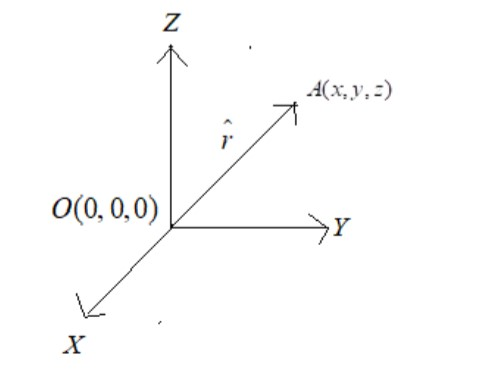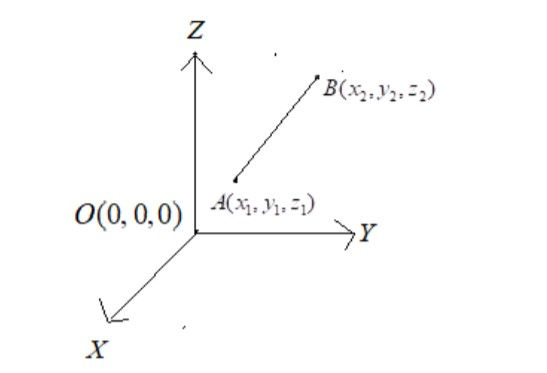
Find the position vector of the midpoint of the vector joining the points $P(2,2,4)$ and $Q(4,1, - 2)$
Answer
483k+ views
Hint:Find the position vectors \[\overrightarrow {OP} \]and\[\overrightarrow {OQ} \]using the fact:
The position vector of $A({x_1},{y_1},{z_1})$ is given by $ \overrightarrow {OA} = {x_1}\widehat i + {y_1}\widehat j + {z_1}\widehat k $
Compute the position vector of the midpoint of P and Q using the formula:
If$ C(x,y,z) $ is the midpoint of segment $ \overrightarrow {AB} $, then we have the position vector of C
$ = \overrightarrow {OC} = \dfrac{{\overrightarrow {OA} + \overrightarrow {OB} }}{2} = (\dfrac{{{x_1} + {x_2}}}{2},\dfrac{{{y_1} + {y_2}}}{2},\dfrac{{{z_1} + {z_2}}}{2}) $
Complete step by step solution:
We are given two points $ P(2,2,4)$and$Q(4,1, - 2) $.
We are required to find the position vector of the midpoint of the vector joining these two points $ P(2,2,4)$ and $Q(4,1, - 2) $
For a point $ A(x,y,z) $, its position vector from the origin $ O(0,0,0) $is denoted by $\overrightarrow {OA} $ and is given by $ \overrightarrow {OA} = x\widehat i + y\widehat j + z\widehat k $
Where
$ \widehat i = $unit vector (vector with magnitude 1) along the X-axis
$ \widehat j = $unit vector along the Y-axis
$ \widehat k = $unit vector along the Z-axis

Consider the origin $ O(0,0,0) $. Suppose we are given two points $A({x_1},{y_1},{z_1})$and$B({x_2},{y_2},{z_2})$.
Then the vector joining the points A and B is denoted by $ \overrightarrow {AB} $

Therefore, the vector joining the given points $ P(2,2,4 )$and$ Q(4,1, - 2) $will be denoted by $ \overrightarrow {PQ} $ and the position vectors of P and Q are\[\overrightarrow {OP} = 2\widehat i + 2\widehat j + 4\widehat k\] and $\overrightarrow {OQ} = 4\widehat i + \widehat j - 2\widehat k $respectively.
Let the midpoint of this vector $ \overrightarrow {PQ} $ be denoted by R.
The question says that we need to find the position vector of this point R.
Consider the formula for the position vector of the midpoint of the segment formed by joining the points $ A({x_1},{y_1},{z_1}) $ and $ B({x_2},{y_2},{z_2}) $.
Let $ O(0,0,0) $ be the origin.
Then the position vectors of A and B are $ \overrightarrow {OA} = {x_1}\widehat i + {y_1}\widehat j + {z_1}\widehat k$and$\overrightarrow {OB} = {x_2}\widehat i + {y_2}\widehat j + {z_2}\widehat k $
If$C(x,y,z)$is the midpoint of segment$\overrightarrow {AB} $, then we have the position vector of C
$ = \overrightarrow {OC} = \dfrac{{\overrightarrow {OA} + \overrightarrow {OB} }}{2} = (\dfrac{{{x_1} + {x_2}}}{2},\dfrac{{{y_1} + {y_2}}}{2},\dfrac{{{z_1} + {z_2}}}{2})$
Using this formula, we get the position vector of the midpoint R of the segment formed by joining the points $ P(2,2,4) $and $ Q(4,1, - 2) $as
$
= \overrightarrow {OR} \\
= \dfrac{{\overrightarrow {OP} + \overrightarrow {OQ} }}{2} \\
= (\dfrac{{2 + 4}}{2},\dfrac{{2 + 1}}{2},\dfrac{{4 + ( - 2)}}{2}) \\
= (\dfrac{6}{2},\dfrac{3}{2},\dfrac{{ - 2}}{2}) \\
= (3,\dfrac{3}{2}, - 1) \\
$
We can write this position vector of R as $\overrightarrow {OR} = 3\widehat i + \dfrac{3}{2}\widehat j - \widehat k $
Hence $ \overrightarrow {OR} = 3\widehat i + \dfrac{3}{2}\widehat j - \widehat k $ is the required answer.
Note: Some students tend to find the equation of the segment PQ for such questions. However, it is not needed here.
The position vector of $A({x_1},{y_1},{z_1})$ is given by $ \overrightarrow {OA} = {x_1}\widehat i + {y_1}\widehat j + {z_1}\widehat k $
Compute the position vector of the midpoint of P and Q using the formula:
If$ C(x,y,z) $ is the midpoint of segment $ \overrightarrow {AB} $, then we have the position vector of C
$ = \overrightarrow {OC} = \dfrac{{\overrightarrow {OA} + \overrightarrow {OB} }}{2} = (\dfrac{{{x_1} + {x_2}}}{2},\dfrac{{{y_1} + {y_2}}}{2},\dfrac{{{z_1} + {z_2}}}{2}) $
Complete step by step solution:
We are given two points $ P(2,2,4)$and$Q(4,1, - 2) $.
We are required to find the position vector of the midpoint of the vector joining these two points $ P(2,2,4)$ and $Q(4,1, - 2) $
For a point $ A(x,y,z) $, its position vector from the origin $ O(0,0,0) $is denoted by $\overrightarrow {OA} $ and is given by $ \overrightarrow {OA} = x\widehat i + y\widehat j + z\widehat k $
Where
$ \widehat i = $unit vector (vector with magnitude 1) along the X-axis
$ \widehat j = $unit vector along the Y-axis
$ \widehat k = $unit vector along the Z-axis

Consider the origin $ O(0,0,0) $. Suppose we are given two points $A({x_1},{y_1},{z_1})$and$B({x_2},{y_2},{z_2})$.
Then the vector joining the points A and B is denoted by $ \overrightarrow {AB} $

Therefore, the vector joining the given points $ P(2,2,4 )$and$ Q(4,1, - 2) $will be denoted by $ \overrightarrow {PQ} $ and the position vectors of P and Q are\[\overrightarrow {OP} = 2\widehat i + 2\widehat j + 4\widehat k\] and $\overrightarrow {OQ} = 4\widehat i + \widehat j - 2\widehat k $respectively.
Let the midpoint of this vector $ \overrightarrow {PQ} $ be denoted by R.
The question says that we need to find the position vector of this point R.
Consider the formula for the position vector of the midpoint of the segment formed by joining the points $ A({x_1},{y_1},{z_1}) $ and $ B({x_2},{y_2},{z_2}) $.
Let $ O(0,0,0) $ be the origin.
Then the position vectors of A and B are $ \overrightarrow {OA} = {x_1}\widehat i + {y_1}\widehat j + {z_1}\widehat k$and$\overrightarrow {OB} = {x_2}\widehat i + {y_2}\widehat j + {z_2}\widehat k $
If$C(x,y,z)$is the midpoint of segment$\overrightarrow {AB} $, then we have the position vector of C
$ = \overrightarrow {OC} = \dfrac{{\overrightarrow {OA} + \overrightarrow {OB} }}{2} = (\dfrac{{{x_1} + {x_2}}}{2},\dfrac{{{y_1} + {y_2}}}{2},\dfrac{{{z_1} + {z_2}}}{2})$
Using this formula, we get the position vector of the midpoint R of the segment formed by joining the points $ P(2,2,4) $and $ Q(4,1, - 2) $as
$
= \overrightarrow {OR} \\
= \dfrac{{\overrightarrow {OP} + \overrightarrow {OQ} }}{2} \\
= (\dfrac{{2 + 4}}{2},\dfrac{{2 + 1}}{2},\dfrac{{4 + ( - 2)}}{2}) \\
= (\dfrac{6}{2},\dfrac{3}{2},\dfrac{{ - 2}}{2}) \\
= (3,\dfrac{3}{2}, - 1) \\
$
We can write this position vector of R as $\overrightarrow {OR} = 3\widehat i + \dfrac{3}{2}\widehat j - \widehat k $
Hence $ \overrightarrow {OR} = 3\widehat i + \dfrac{3}{2}\widehat j - \widehat k $ is the required answer.
Note: Some students tend to find the equation of the segment PQ for such questions. However, it is not needed here.
Recently Updated Pages
What percentage of the area in India is covered by class 10 social science CBSE

The area of a 6m wide road outside a garden in all class 10 maths CBSE

What is the electric flux through a cube of side 1 class 10 physics CBSE

If one root of x2 x k 0 maybe the square of the other class 10 maths CBSE

The radius and height of a cylinder are in the ratio class 10 maths CBSE

An almirah is sold for 5400 Rs after allowing a discount class 10 maths CBSE

Trending doubts
The Equation xxx + 2 is Satisfied when x is Equal to Class 10 Maths

Why is there a time difference of about 5 hours between class 10 social science CBSE

Who was Subhash Chandra Bose Why was he called Net class 10 english CBSE

Change the following sentences into negative and interrogative class 10 english CBSE

Write a letter to the principal requesting him to grant class 10 english CBSE

Explain the Treaty of Vienna of 1815 class 10 social science CBSE




